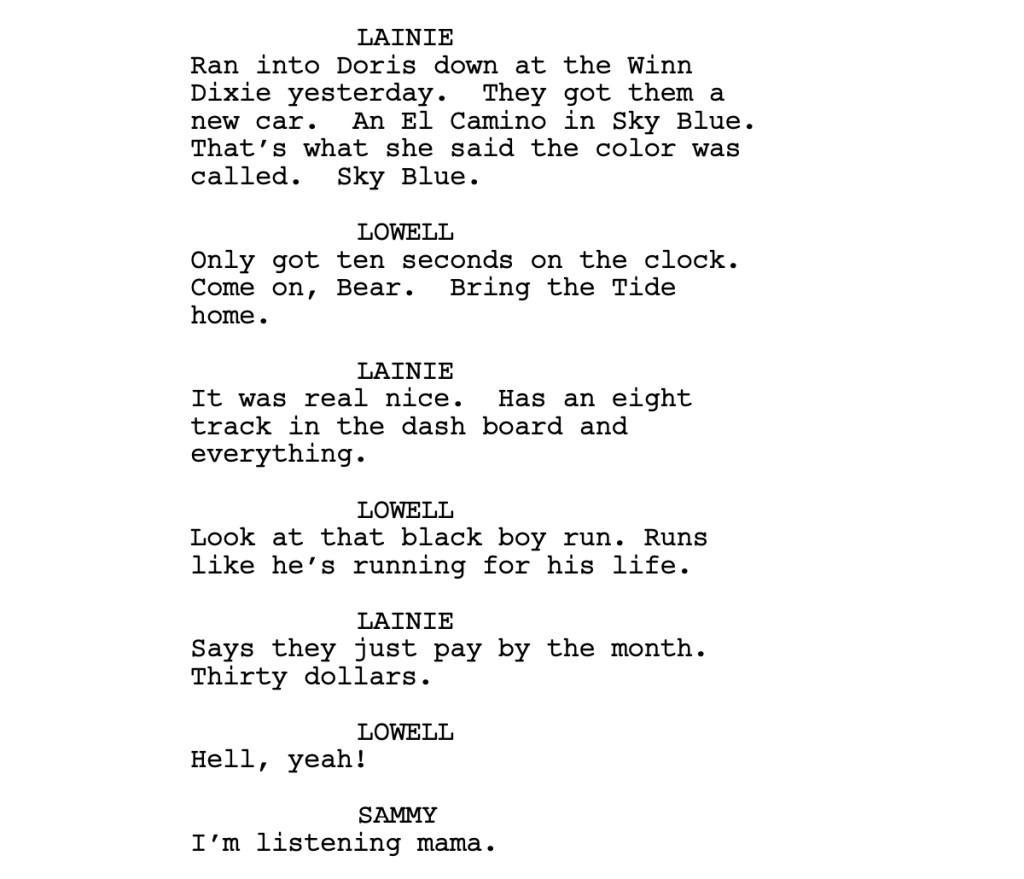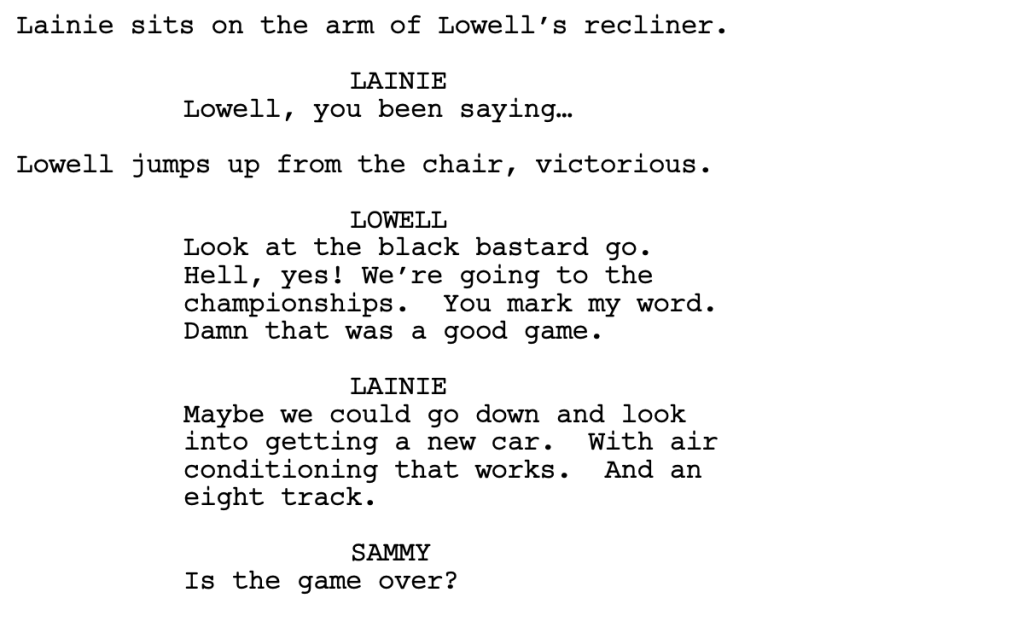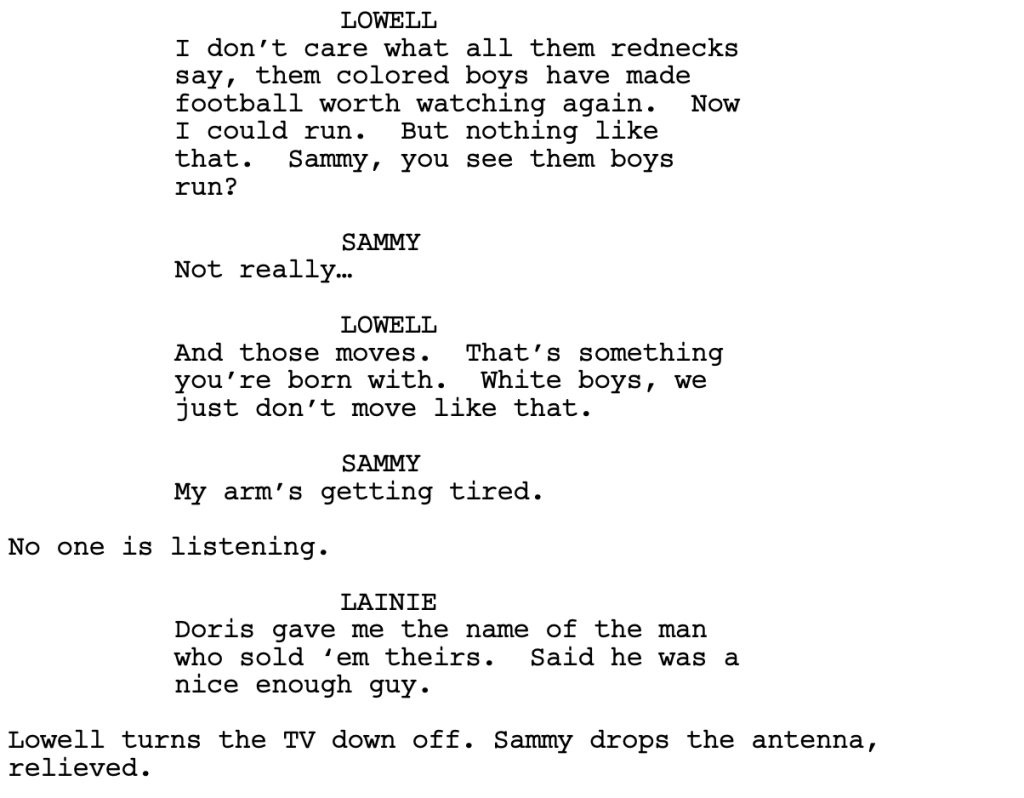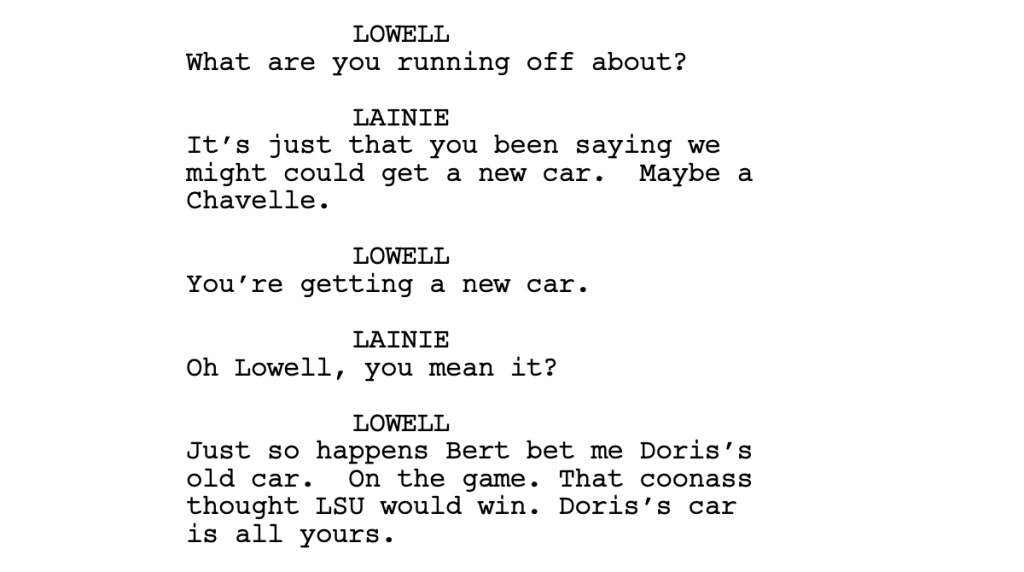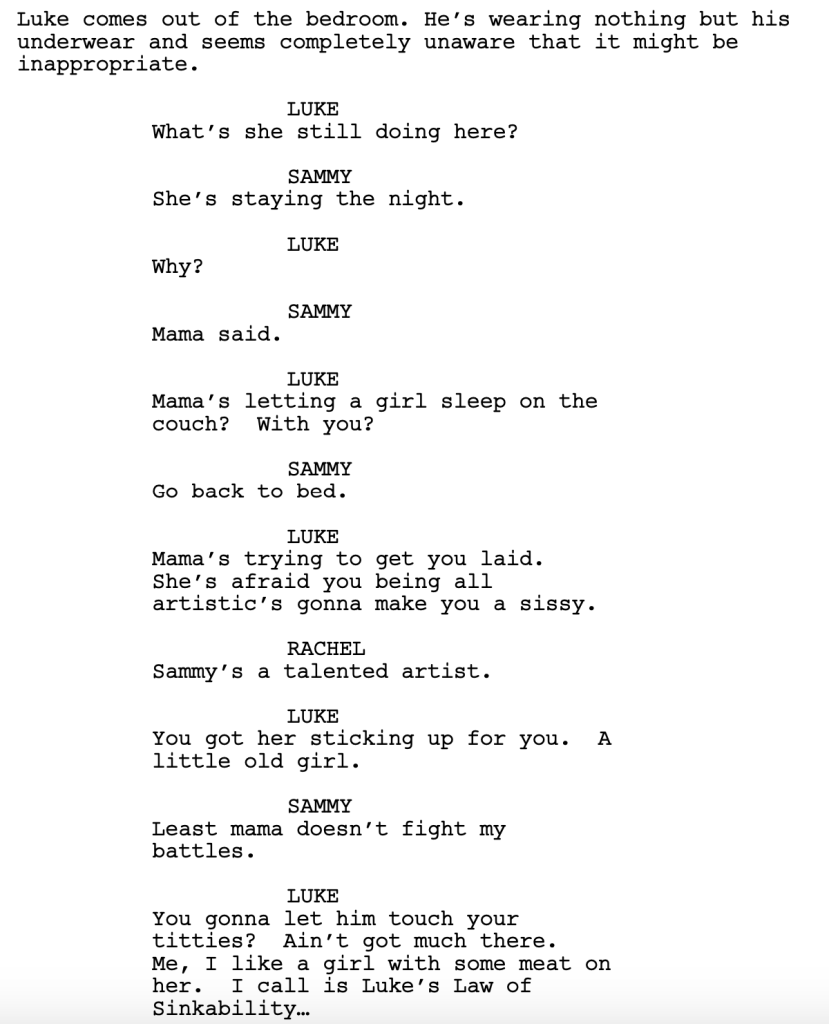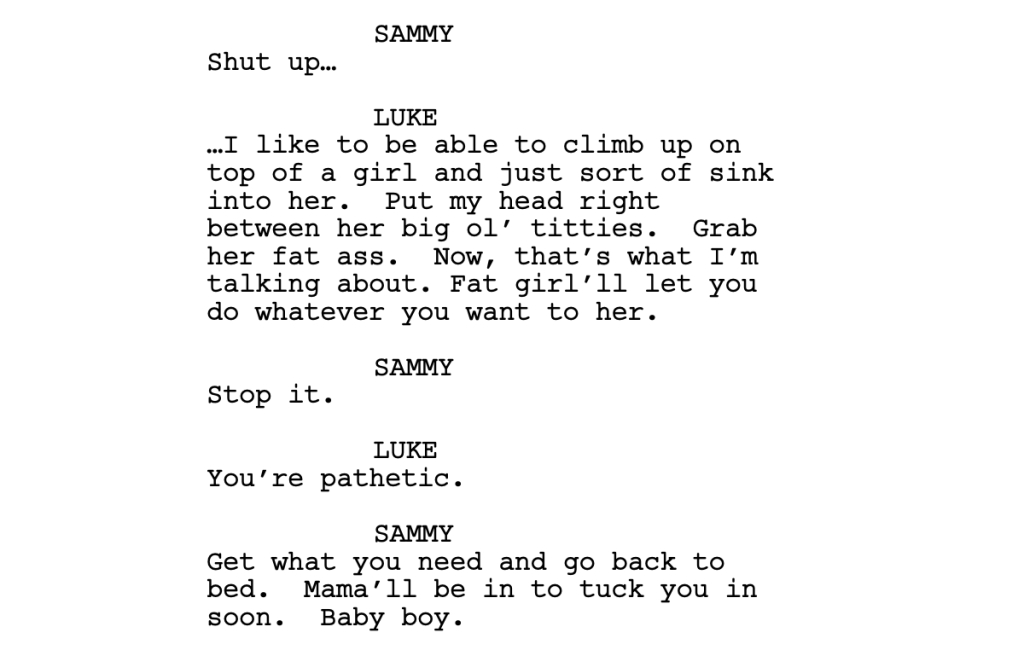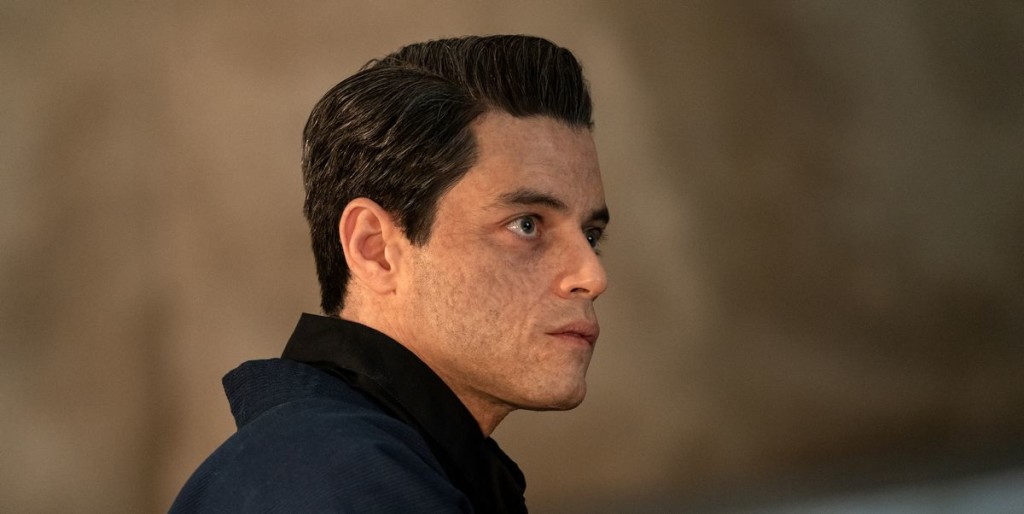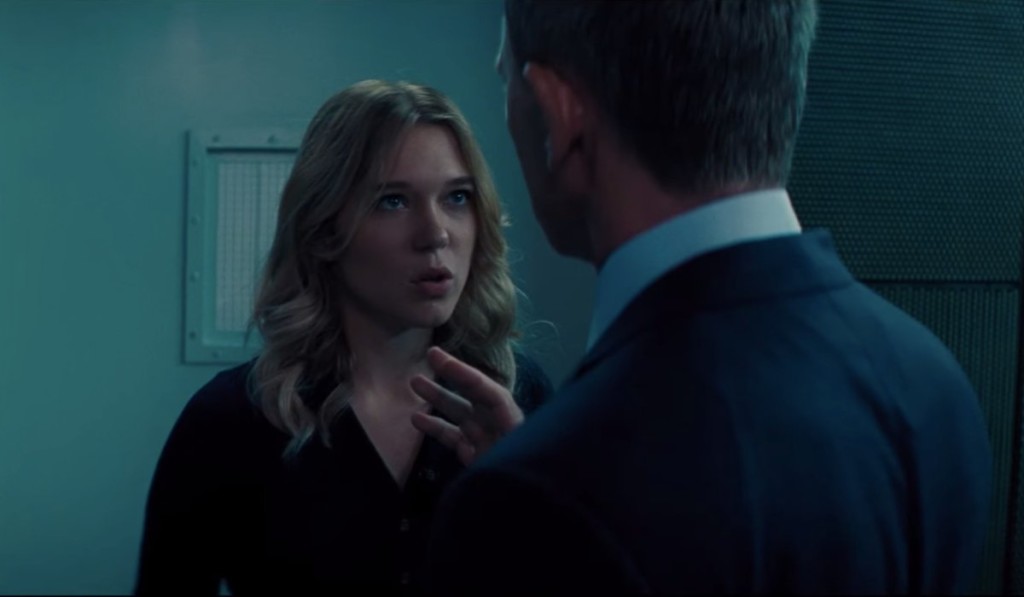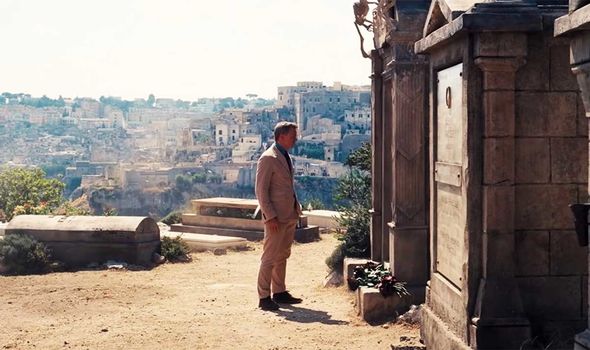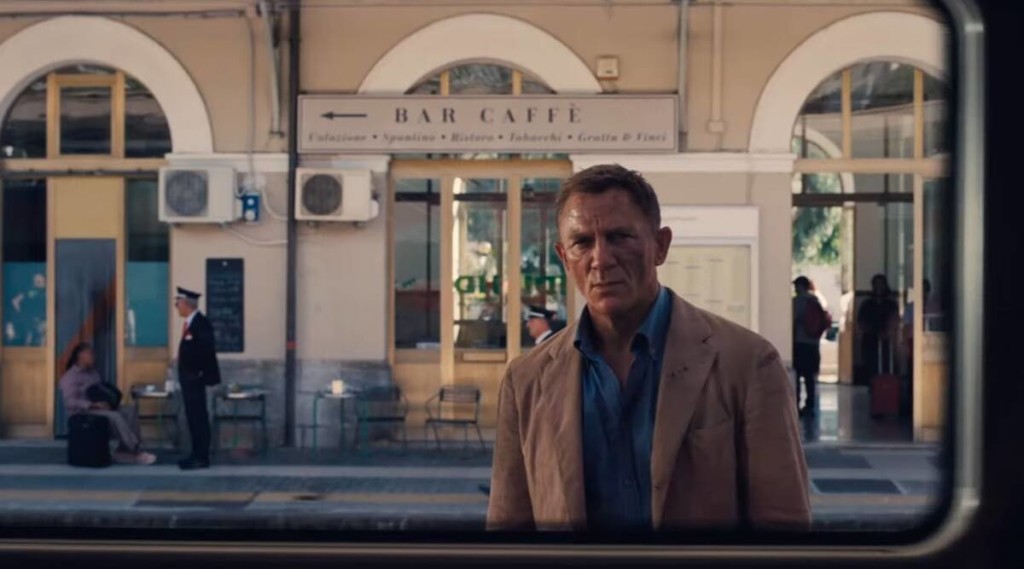Search Results for: girl on the train
Is this the best unknown screenplay in Hollywood?
Genre: Drama
Premise: In 1971 Alabama, a poor, gifted, teen living in a trailer with his abusive family is shocked when the prettiest girl in school pays him a visit and asks him if he’ll do her a giant favor.
About: This script was sent to me for a consultation by a director named Ravin Gandhi. The writer, Elyzabeth Gregory Wilder, originally wrote it as a play. She has since adapted it into a screenplay. Wilder has had her plays produced at the Royal Court in London, Alabama Shakespeare Festival, Denver Center, the Hartford Stage, amongst many others. She’s now looking to expand into a screenwriting career. You can learn more about her at her website. By the way, there are a lot of twists and turns in this script. So I encourage you to read it before the review so you’re not spoiled. The link to the script is at the bottom of the review. :)
Writer: Elyzabeth Gregory Wilder
Details: 111 pages
Okay, a little backstory here. Director Ravin Gandhi made his first film a couple of years ago and the biggest lesson he learned, during that process, was how important it was to have a great script. You have a great script, you get better actors. If you have better actors, you get a bigger budget. You have a bigger budget, you get a better team. You get a better team, you get better production value. And, of course, all of those things lead to a bigger and better distribution deal.
So, for his second movie, he made it his number one priority to find a great screenplay. After scouring every corner of the internet and as many agencies that would give him the time of day, the casting director who’d worked on his first film told him she knew a really great playwright who’d written this amazing play. Would he like to take a look?
Ravin said sure with zero expectations, read the play, and was blown away by it. That’s where I came in. He sent it to me, basically wanting to know from the guy who’s read everything, if the script was as good as he thought it was. I hate being put under that kind of pressure because 99 times out of a 100, I have to tell the person, ‘No, it isn’t as good as you think it is.’ But this time, it was.
Spirit of Ecstasy takes place in 1971 Alabama and follows 17 year-old Sammy, a poor shy boy who attends a local private school on scholarship. Unlike almost anyone else in Alabama, Sammy loves to draw, loves to create, loves to explore art. Unfortunately, because he’s poor and likes all these weird things, he doesn’t have any friends.
Sammy lives on a salvage yard in a trailer with his unabashedly “white trash” family. There’s 16 year-old troublemaker Luke, as cool and handsome as Sammy is shy and anxious. There is Lainie, Sammy’s mother, a once optimistic local beauty who’s been relegated to cutting coupons and staring at advertisements for nice neighborhoods she’s never going to live in. And then there’s Lowell, a local football star who’s become a beer-guzzling waste of space.
After Sammy comes home from school one day, we learn that he’s secretly fixing up one of the cars in the junkyard so that, when he’s old enough, he can leave this place. That opportunity may be coming sooner than he thinks. That night, there’s a knock on the door. Lainie goes to answer and is baffled at what she sees standing there – a beautiful girl.
This is Rachel, the most popular girl at Sammy’s school. Lainie isn’t sure what’s more surprising, that someone from the “right side of the tracks” is visiting them or that Sammy knows a girl. She immediately invites Rachel in and begins her southern hospitality routine. Later, once Rachel is able to get Sammy alone, she asks him if he’ll do her a favor and drive her to New Orleans. Sammy doesn’t know what to say.
As dinner rolls around, an increasingly pale-looking Rachel scurries off to the bathroom to throw up and that’s when we learn the true reason why she’s come. She’s pregnant. And she needs to get to New Orleans to get an abortion. She can’t have anybody in town knowing about this, which is why she’s come to the one family nobody cares about.
As Rachel carefully orchestrates the evening so that she can stay the night, she begins to see how abusive Sammy’s family really is. There are things going on behind closed doors that shouldn’t be happening, which only increases the urgency of her and Sammy having to leave.
After giving Sammy the first kiss of his life, she conspires with him to make a run for it before dawn, which Sammy agrees to. But we can’t help but wonder if Rachel’s adoration for Sammy is all just a ruse to get what she needs. Once she’s taken care of her problem, will she ditch him? We may never find out because Lainie discovers their secret plan and goes into nuclear preventative mode to stop her son from leaving her. Pulled between Rachel and his mother, Sammy will have to make the biggest decision of his life. What will he do?
There are soooo many things I liked about this script.
Let’s start with the plot. You guys have heard me go full hater-mode on drama scripts. Writers seem to think that the Drama genre gives them permission to be boring. Look no further than yesterday’s script, Rewired. The Spirit of Ecstasy shows you how to do it right. What’s the big difference? They use a time constraint.
This story doesn’t take place over a summer, a month, or even a week. It takes place in one night. That urgency covers up all of the problems that usually sink drama scripts because we know the issue is going to be resolved within the next 12 hours. That’s how you do drama. It’s the same idea behind 1917. A typical movie about World War 1 in 1917? Nobody cares. But make that story real-time and all of a sudden, “Wow, this is cool.”
That’s initially what pulled me in – just how fast a drama script was moving. I’m not used to that.
Next up, I loved the dramatic question at the center of the story. Dramatic questions are questions you can pose in your script that, if they’re compelling enough, make the reader want to stick around to find out the answer. The dramatic question in Spirit of Ecstasy that hooked me was, “Is Rachel conning Sammy?” Is she pretending to like him because she’s desperate to fix this problem she has? Or does she really like Sammy? Or does she go in planning to con him, but then actually starts to fall for him?
The fact that I was never entirely sure kept me flipping the pages. I had to know if Rachel was honest or not.
From there, the script exhibited an authenticity regarding the time and place that I rarely see. I’ve read scripts about the south in the 70s before. They all fall into the same stereotype traps. From everyone’s super religious to everyone’s a hick to they’re all walking around with guns. This feels different. Sammy is far from your typical southern stereotype. He’s smart and artistic and dances to the beat of his own drum. Even when the characters in Spirit do move towards “stereotype” territory, their actions and dialogue are so specific that it never feels fake or “written.”
By the way, that’s how you avoid cliche. You emphasize specificity. The more specific you can be about a time or place and how people act, that’s what makes your script feel real. The more vague you are, the more cliche you will be. It’s the difference between saying a tennis player “hits a forehand” and a tennis player “slides across the red clay, crushing a forehand down the line, past the outstretched racket of his opponent.”
Which leads us to the biggest star of the script – the dialogue. It’s been a while since I’ve read dialogue this good. The best way for me to identify good dialogue is when I never once am aware of the dialogue. Typically, when I read a script, I can feel the writer’s thought pattern as they’re writing the words of their characters. You sort of see them working out in their head what the characters need to say in the scene.
That never happened once in Spirit of Ecstasy. Every time people spoke, I became lost in their conversations. So much so that I would encourage anyone who wants to be a good dialogue writer to read this script. Because there are so many dialogue lessons you can learn from it.
Take this early conversation from page 9. We’ve just come into the trailer for the first time. We’ve been introduced to his parents, Lainie and Lowell. Lowell is watching the football game, making Sammy hold up an antennae to keep the picture clear. Meanwhile, Lainie is going through the newspaper, looking at houses and cars for sale. We pick up the conversation mid-scene…
This is a dialogue tool that all of you should have in your arsenal. A lot of amateur writers get tripped up in assuming that dialogue must be logical. It must be a ‘your turn, my turn’ exchange of information where every question must be answered with a cohesive insightful response. No. Real life conversation is much messier than that. One of the cool ways you can take advantage of this is by writing conversations where the characters rarely, if ever, respond to the other character, which is what you see here.
But it’s not just a cool trick. Notice how this dialogue does three things. One, what Lainie’s talking about – wanting to get a nice new car so that she can look respectable – tells us EXACTLY who her character is. We know Lainie after this scene. Two, what Lowell talks about – his obsession with the game, his not so subtle racist remarks – tells us exactly who he is. This is a simple man with a simplistic view of the world. And three, it tells us exactly who these two are AS A COUPLE. Their (non) conversation tells us everything we need to know about this marriage within a minute.
That’s what great dialogue is. It’s entertaining in and of itself. But it’s also teaching us things about the people saying the words.
Another one of my favorite dialogue exchanges happens later in the script. **BIG SPOILER contained in the below example** We’ve hinted, at this point, that Lainie is sexually abusive towards Luke. But this is something that’s never spoken about in the house. In this scene, Luke has gotten ready for bed and is passing by Sammy and Rachel, who are on the couch.
Good dialogue does more than one thing at a time. At first glance, this scene is about Luke making fun of his brother regarding his lack of sexual experience. The dialogue is funny, albeit in an uncomfortable way. But take a closer look and pay attention to what Luke is saying. Luke’s sexual experience is limited as well, exclusively to his mother. So even though he’s offending Sammy here, what he’s really talking about is his own sexual abuse.
This is highly advanced stuff that I rarely see in screenwriting these days. Nobody understands subtext. Or, the ones who do, are too busy rushing through the script to come up with any clever ways to explore what’s happening beneath the surface. The writer is telling us, without having to ever tell us, that Luke is being abused by his mother. In bad scripts, writers will have their Luke character walk straight up to their mom and say: “You need to stop sexually abusing me mom!” “I’m not sexually abusing you.” That’s an uninteresting way to explore the issue. Instead, you want to talk around it, talk under it, talk about it abstractly, hint at it in conversations with other characters. Not only is that more true to life, it leads to much more interesting conversations.
I could go on about this script for a long time. I think the characters are, honestly, the kinds of roles that win actors Oscars. The structure is so tight that it makes what’s, essentially, a bunch of characters speaking for 90 minutes, go by faster than you can snap your fingers. And the dialogue is consistently awesome. It’s kind of reignited my belief that there are really good screenplays out there waiting to be discovered. Check it out for yourself and let me know what you think in the comments!
Script link: Spirit of Ecstasy
[ ] What the hell did I just read?
[ ] wasn’t for me
[ ] worth the read
[x] impressive
[ ] genius
What I learned: This reinforces my belief that dramas can almost become de facto “thrillers” if you add a really tight time frame. For that reason, I encourage anyone writing a drama to consider tightening the time frame of your story. You may be shocked at how much it improves the script. As I told Ravin, “This doesn’t work if it takes place over one week. Or even two days. It works specifically because it takes place over 12 hours.
In the vein of Dude, Where’s My Car and Pineapple Express, we get… like, uhhh, whoa mannn, what is this review about again? Oh yeah! Huh huh huh. The Aliens Are Stealing Our Weed!
Genre: Comedy
Premise: When two best friend pot-farmers wake up one day to find their entire crop of weed gone, they quickly come to realize it was the work of aliens.
About: Today’s script comes from Ryan Firpo, half the writing team for the upcoming Marvel flick, The Eternals (the other half is Ryan’s brother, Kaz). Ryan wrote and directed a short film called, Ten Years, in 2016, about a 10 year marriage reunion in Vegas that doesn’t go as planned. The short generated a lot of buzz, leading to Kevin Feige seeing it and hiring Ryan and his brother to write Eternals. The Firpos used that buzz to finish in the top spot for the 2017 Black List with their script, Ruin, which I reviewed here. Gina Rodriquez and Paramount are teaming up for “Aliens.”
Writer: Ryan Firpo
Details: 420 pages (just kidding – 111 pages)
Readability: Mostly fast
Sources on this one say it was picked up because Paramount thought it fell in line with other Paramount comedies like “Anchorman,” “Airplane!” and “Blazing Saddles.” Absurdist wild comedy has not generally done well here on Scriptshadow. But you guys know I like me some aliens. So maybe aliens stealing weed is going to change all that!
20-something best friends Candice and Izzy are living out in the middle of Nowhere, Washington, growing weed, buuuddddyyyy. Candice is like the weed-growing version of Walter White. She’s an Ivy League biologist drop-out who’s using computers to create the perfect strain of weed, what she calls, “Candizzy Chronic.”
Candice and Izzy share their ten acres of land with Cheech and Chong. I mean, the characters’ names are Bob and Jerry. But make no mistake, they will be played by Cheech and Chong. Or whoever the names of the actors who play Cheech and Chong are. Bob and Jerry always come by and, like, steal their weed. But it’s all good. They’re harmless. And at least they provide feedback on the strain, which they think is righteous, brother.
Once the crop is completed, weed buyer Reggie Sanchez shows up to test it. It takes him less than two seconds to declare Candizzy Chronic the best strain of weed he’s ever smoked, yo. He wants to buy the entire crop. Yeah baby! After years of raking dirt, Candice and Izzy are about to rake in the cash.
Except that the very next day, the weed is gone! Candice and Izzy charge over to confront their primary suspects, Bob and Jerry. But the clueless morons say all their weed has been stolen too! The rookie investigators realize that Reggie Sanchez must have done it, and they know where he’s going – Cannacon in Seattle. So off they go!
They find Reggie there, secretly follow him to his room, and then watch as he takes his human skin off to reveal that he’s an alien! WTF!!! Freaked out, Izzy says they HAVE to go to the FBI. “Do you know what they’ll think of us if we tell them an alien stole our weed?” Candice counters. You’re right, Izzy says. We have to go to the one person in the government we know, DEA Agent Mike. Who happens to be Candice’s ex-fiance!!!
Mike thinks this is obviously a made up story stemming from smoking too much Mary Jane. But after the girls beg him to help, he reluctantly comes back with them to their stolen crop. While Mike’s investigating, he looks up to see…. A flying afro??? Yes, it’s a flying afro. The group chases the afro, finally catches it, and figures out it’s some sort of drone that scouts land for good marijuana.
They allow the drone to lead them back to the alien mothership, where Frank, a 100 million year old alien, explains that in order to save humanity from killing each other, they’re going to drop the world’s weed supply into all the volcanos and hot box earth for the next 200 years to chill everyone out. Will Candice, Izzy, Bob, Jerry, and Mike go along with their plan? Or will they stop the aliens???
I still think that the best jokes come from conflict.
When there’s no conflict, the characters are just riffing, pushing out try-hard jokes, and while some hilarious writers are able to make this work, it’s often eye-rolling stuff.
You need legitimate conflict for laughs.
That’s why Pineapple Express was so successful. It wasn’t two best friends running around making pot jokes. It was a normal guy and his drug dealer. They lived completely different lives and had completely different life experiences, which is what created the conflict.
Where that really helps you out in a script is when your pairing encounters a high-stakes choice, one where if they make the wrong decision, there’ll be dire consequences. That’s when two people with diametrically opposing views on life pays off. Because they’re going to have two completely different solutions, and that’s going to result in a lot of laughs.
Candice and Izzy are best friends. There’s zero conflict there. Like none. And so they basically just agree with each other the entire movie. And, sure, there are some funny exchanges. But I’m telling you, it’s really hard to keep the joke quality high when the conflict is nonexistent.
That’s why I loved the choice to bring Mike in, the ex-fiance. He contributes some legitimate conflict to the dynamic. There’s a lot of unfinished business between him and Candice, which creates a lot of subtext. Candice had a normal life and an amazing future and ran off to start a pot farm. Mike can’t understand that choice. And he carries that grudge into every conversation.
But even then, Firpo ends up mining that conflict more for drama than comedy. I would’ve liked it if, for example, Izzy saw Mike as a threat to her current friendship with Candice. If he wins her back over, she could leave Izzy. So you’d have the two sort of fighting over Candice in a way. Or you could’ve had Mike be an asshole who had dumped Candice. And Izzy is now super-protective over Candice. You could’ve gotten a lot of humor out of her being an asshole to Mike.
To Firpo’s credit, he does go deeper than most comedy writers on the character front. He attempts to create this whole backstory where Candice had this Ivy League education and perfect future and the husband of her dreams, but she ran away from it all. She’d always used weed during the relationship to escape her feelings. Now she used weed, in the form of a career, to escape a future with Mike. So she’s used weed to avoid everything in her life and her journey is about facing up to that issue.
But even then, it doesn’t really matter, because a comedy script is nothing if it’s not funny. And this didn’t have any five-star knee-slappers. In fairness, Firpo is targeting a younger demo. Paintball shots to the balls and flying afros are probably going to be funnier to your average coed. Only had a few chuckles myself, though. So I wouldn’t recommend this.
[ ] What the hell did I just read?
[x] wasn’t for me
[ ] worth the read
[ ] impressive
[ ] genius
What I learned: There are exceptions to this rule, of course (Dumb and Dumber comes to mind), but you generally have two choices when you create a pairing for a comedy. Either make them two people who do not like each other and don’t want to be together (The Other Guys) or two people with diametrically opposing views of how to live life (a staunch conservative and knee-jerk liberal, for example). If you pair up two best friends who generally see the world the same way, you’re leaving a lot of laughs on the table.
Has a Daniel Craig James Bond film finally won me over???
Genre: Action
Premise: James Bond is pulled out of retirement to hunt down the owners of a dangerous new virus that can target its victims through their specific DNA profile.
About: There probably isn’t a movie that has been more hurt by the pandemic than James Bond’s latest jaunt. The movie had rolled out practically its entire promotion when it was suddenly delayed. And, since then, they’ve been notably gun-shy about when to open it. They finally took their shot over the weekend and it didn’t go well. While films like Venom and Shang-Chi have nearly reached 100 million in their opening weekends, No Time To Die cleared only 56 million. It turns out there was way too much time to die. It’s a sour note on the franchise’s best run ever. But hey, that’s the pandemic for you!
Writers: Neal Purvis & Robert Wade, Cary Fukunaga, Phoebe Waller-Bridge (characters by Ian Fleming)
Details: 165 minutes!
I think James Bond’s weak box office in the wake of recent over-performers Shang-Chi and Venom is telling the market something. Which is that, at this moment, audiences don’t want real life. They want fantasy. Now I know chasing around DNA-specific viruses and hunting down burn victim gardener villains who wear baby masks isn’t real life real life. But Bond is about as close to a “real life” blockbuster as we get these days. And audiences have told you exactly how they feel about that.
Which is too bad. Because in a market that’s becoming increasingly dependent on fantastical characters acting within fantastical worlds, James Bond, in a 180 turn from a decade ago, has become the one unique option on the menu. There’s nothing else like him out there in 2021. So to see audiences turn on him in favor of CeeGeeI McSpecialEfects is a little disheartening.
However, we now know what people want at this point in the pandemic and that is pure escapism. Take us far far away from the real world so we can forget about all this craziness for a couple of hours.
Now, as you know, I’ve had a rough go of it with my buddy Bond these last 15 years. I have not been his BFF. Heck, I haven’t even been an acquaintance he can borrow a couple of bucks from. So, naturally, I wasn’t expecting to be wowed by the latest installment. Let’s see if a bionic eyeball, a face that got stuck in the toaster for too long, and a scene politely borrowed from Silence of the Lambs won me over.
If you haven’t seen the film, James Bond is retired and traveling the world with his wife, French psychiatrist Madeleine. While visiting the grave of an old flame, the grave blows up, and Bond barely survives. Convinced that Madeleine set up him, he leaves her.
Five years later, Bond is lured out of retirement to find a terrorist in Cuba. He and a local female agent, Paloma, infiltrate a SPECTRE party, which stops mid song, as a spotlight reins down on Bond. They knew he was coming! A mist then appears in the air and everyone around him starts dying, even though he’s okay.
Bond and Paloma fight their way out and Bond now has no choice but to rejoin MI-6. His first mission is to visit his nemesis, Blofeld, in a psychiatric hospital, to find out what that misty stuff was all about. But Blofeld will only talk to him if a specific psychiatrist is present – Madeleine!!!
Bond then accidentally kills Blofeld with the same thing that killed the rest of SPECTRE. It turns out that someone’s developed a virus that is DNA specific. You can program it to kill only certain people. While Bond takes that in, Madeleine and her previously hidden 5 year old daughter (don’t worry, we’re told right off the bat it’s not Bond’s) are kidnapped by Lyutsifer Safin, a guy who never wears sunscreen, who has unfinished business with Madeleine. Bond will have to go to Lyutsifer’s secret island to get her back… AND SAVE THE WORLD!
One of the themes of my screenwriting advice is to surprise the reader. Give us things we’re not expecting. It’s one of the hardest things for a screenwriter to do because your mind is hardwired to use stuff you’ve already seen before. Something that’s previously existed is always going to be more prominent in your head than something that has never existed. It takes discipline to ignore that known image, that familiar plot beat, that twist, that turn, from previous movies and come up with your own.
So I have to say I was impressed with how much Fukunaga surprised me. He didn’t do anything earth-shattering. But it became clear to me during many of the movie’s scenes that he was actively trying to keep the viewer off balance. And I loved that.
The first moment this occurred was when Bond went to the grave site of his old girlfriend. I loved that Fukunaga leaned into the dramatic music, the sadness of the moment, all the cliches that usually come from visiting a grave in a movie. I was right on the cusp of falling asleep. And then the front of the grave blew up, launching Bond backwards 30 feet. As soon as that happened, I sat up, and I said, “Okay, we have a movie now.”
The second time this happened was when Bond drove Madeleine to the train station after he believed that she deceived him. We’ve seen many “One lover leaves another lover on a train” scenes before. So I loved that this played out the exact opposite way of how all those scenes did.
In this version, these aren’t two lovers sadly leaving each other. It’s two people breaking up. And the person outside the train isn’t chasing anybody. He’s standing still. It’s the person inside the train, Madeleine, who’s running backwards through the cars to try and convince James with one last look that she didn’t deceive him.
Again, it’s not a crazy good scene. And I’m not sure anybody noticed this but me. But there’s a bigger point to be made here. Which is you could tell Fukunaga and the writers worked really hard to try and make these traditionally stereotypical moments feel fresh and different.
The third time this happened was when Bond went to Cuba to infiltrate the SPECTRE PARTY. When he gets to the heart of the party and everyone backs away as a spotlight washes over him, again, I thought, this is really unexpected. Usually, in these scenes, Bond (or Bourne, or Wick, or Turetto) expertly executes his mission until all hell breaks loose. I was constantly jolted out of my assumptions in No Time To Die and that kept this Bond more exciting for me.
The set pieces were all really good as well. A lot of them don’t transfer well to the page, unfortunately, because they’re built on the uniqueness of the location. Like when Bond is zipping up and down those tiny hilly streets in Italy(?). If you would’ve asked someone how that scene read in script form, they would’ve told you they were bored.
Luckily, there was one relevant “writing choice” set piece we can learn from. That happens after Bond came back to see Madeleine at her rural house, noticed that bad guys were coming, and jumped in the car with her and her five year old daughter. I know it seems, on the surface, like a mundane decision to have the daughter in the car during the chase. But we’re used to seeing chases where it’s only the hero behind the wheel, or the hero with someone in the front seat. We don’t often get kids in the car. And I noticed I was way more into the chase as a result. I was terrified for that little scared girl. It just goes to show there’s always a choice around the corner than can super-charge your scene. So push yourself and ask, “Can I do more with this scene?”
The reason I’m not scoring No Time To Die off the charts is because it still has the same problems as every Bond film. There are so many moving parts to the plot that you need to take a local University course on the movie to keep up. From Project Heracles to Blofeld to SPECTRE to Lyutsifer Safin, I’d consistently get lost as to where Bond was headed and why. It wasn’t as bad as previous Bond films for me. But it’s always hard to enjoy something when you’re never quite sure what’s going on.
**MAJOR SPOILER**
As for Bond dying, I don’t have much of an opinion on it to be honest. It’s not like Han Solo dying where you know he can’t come back. Everyone knows Bond will be back in three years. And they don’t even have to explain why he’s all of a sudden alive again because it will be a different actor playing him and we’ll all just go with it. Also, Bond has never been a real person to me. He’s a wish-fullfiment version of the ideal man, a fantasy of sorts. So I don’t hold any particular emotional connection to him. I guess it makes sense in that it’s the death of Daniel Craig playing the part. But I don’t know. It didn’t do much for me.
In the end, I liked the latest Bond. It’s packed with some really good set pieces and lots of unexpected moments. Worth the price of admission for sure.
[ ] What the hell did I just watch?
[ ] wasn’t for me
[x] worth the price of admission
[ ] impressive
[ ] genius
What I learned (spoiler edition): If you want to sell a twist, LIE HARD to your audience. I actually learned this trick all the way back in Shawshank Redemption. When Andy gets that tiny rock hammer and Red says to us, “Make no mistake, Andy couldn’t do anything with that hammer. It would take a man 600 years to dig a tunnel with that tool.” As soon as he said that, I slumped my shoulders and thought, “Dammit! I thought he was going to escape.” Same thing here. When we meet Madeleine’s daughter, one of the first things Madeleine says to Bond is, “She’s not yours.” It’s so direct and blatant that we buy it wholesale. Which makes the twist that she IS his daughter a shock.
Wait a minute. This script sold for 3 million dollars??
Genre: Comedy/Horror/Blockbuster?
Premise: When a man comes to a psychiatrist claiming to be a werewolf, the psychiatrist attempts to videotape his transformation to prove to him that he’s merely hallucinating, but is shocked to learn that the man is telling the truth.
About: Is Hollywood ruthless or what? It’s 1992. You wrote the crowd-pleasing movie of the summer that got an actress her first Oscar in “My Cousin Vinny.” You struggle for a couple years. But then, in 1997, you write a werewolf script that sells for THREE MILLION DOLLARS to Dreamworks, a deal that Steven Spielberg himself brokered. I’d say life is good, right? Except screenwriter Dale Launer would only get three more produced credits in the next 25 YEARS. Those credits? Eddie. Tom Nu’s Heaven. And The Hustle. Ouch. Might Bad Dog have changed his fortunes had it been made? Let’s find out!
Writer: Dale Launer
Details: 118 pages – 1997 draft
Readability: Medium to Fast
As Scott pointed out to me, this script was purchased right after the birth of Dreamworks, Steven Spielberg’s company. When you’re a new company and have a lot of money, you make big splashy sales to announce yourself. Nobody’s going to put you above the fold if you buy a script for $250,000. But three million? That’s a front page story on Variety right there.
This is a rare look into the minds of two of the biggest names in Hollywood, Steven Spielberg and Jeffrey Katzenberg. These two PERSONALLY brokered this deal, which tells you EXACTLY what they like. I bring this up because Spielberg is still involved in his company, Amblin Entertainment, where he’s still buying Spielbergian things, like the Tom Hanks movie, Finch. “Bad Dog” tells me he wants to make a werewolf film.
What often happens with creatives is that once they get their minds set on making a certain type of movie, they *will* make that movie eventually. I saw this with the Russo Brothers. A decade ago they bought a script about a guy who came back from war and robbed banks. After developing it for a while, they abandoned it. A decade later, they optioned the book, “Cherry,” about what? About a guy who just got back from war who starts robbing banks.
I guess what I’m trying to say is, if you have a great werewolf script, get it to Steven Spielberg. He may want to make it. While you’re taking care of that, let’s figure out why he threw three million dollars down the drain.
45 year old Griffin Black is a nationally renowned psychiatrist whose schtick is to “control your emotions.” One day, Griffin’s visited by a guy named Archie who desperately needs his help. According to Archie, every full moon, he turns into a werewolf. But not just any werewolf, a werewolf that grows bigger and fiercer with every human he eats.
Griffin nods along before explaining to Archie that he’s having hallucinations. What if I proved it to you, Archie asks. Would you believe me then? Sure, Griffin says. Why not. So they go to Griffin’s remote cabin and tie Archie up in preparation for when he “transforms.” Griffin then pops on his video camera and starts taping. Needless to say, Griffin learns fairly quickly that Archie wasn’t lying.
In fact, Archie breaks free of his restraints and the next thing Griffin knows, he’s jumping into his Ferrari and speeding the hell out of the forest – WITH A GIANT WEREWOLF JUST INCHES BEHIND HIM. Griffin gets to a paved road and shoves the car into 4th gear, climbing up to 100 miles per hour. But the werewolf is STILL behind him! It’s only when Griffin gets up to 120 that he’s able to ditch the monster.
Griffin runs to his new girlfriend, criminal attorney Marcy, and explains what just happened. She, of course, doesn’t believe him, so they set up a SECOND taping session so that Marcy can see what he saw. Unfortunately, as they’re getting the experiment ready, 12 cop cars show up. They’re arresting Archie for his suspicious ties to several dozen people who were killed in a remote town.
Guess what that means. That means Archie is going to be arraigned in court ON A FULL MOON. Griffin does everything he can to convince people that Archie is a werewolf and that if they don’t restrain him, they’re all going to die. But they ignore him. And boy do they regret it. During the court session, Archie transforms and immediately jumps onto the judge and BITES HIS HEAD OFF.
After fleeing, Griffin explains to Marcy that he had a bunch of silver bullets special made just in case this happened. So they locate a gun and off they go to try and find Archie. Except Archie is busy running through Los Angeles, eating everything in sight. He even pops by LAX and eats an entire plane full of passengers! It’ll be up to Griffin now – who’s never fired a gun before – to find Archie, shoot him down, and stop the killing!
Remember how I told you a couple of weeks ago that one great set piece can sell a script? Never has there been more proof of that than Bad Dog. I know EXACTLY why this sold. And, after reading the plot synopsis, you should too. Giant were-beast chases Ferrari going 100 miles per hour. That’s why this sold. Spielberg loves a great chase scene and this was the faster crazier version of his famous T-Rex jeep scene. It’s a really cool scene. But is it the only thing this script has going for it?
Actually, no.
Bad Dog may not be reinventing the dog bowl but it’s a script that understands something a lot of writers have forgotten since the 90s. Which is that you shouldn’t be writing screenplays. You should be writing MOVIES. Ironic, I know, since this never became a movie. But it should’ve. I’m sure the reason it didn’t was the same reason any Spielberg project gets killed – he’s got a million projects he wants to do and he can’t make them all.
I’m going to tell you where this script won me over. It was the point where Griffin was about to prove to Marcy that Archie was a werewolf. I was reading it thinking, ‘Oh boy. Here we go. We’re going to repeat the beat in the story WE JUST SAW when Griffin watched Archie become a werewolf.’ But then the cops showed up and arrested Archie. My mind immediately switched over to, “Ohhh, okay. We’ve got a movie now.”
Why do we have a movie?
Because watching somebody change into a werewolf in a controlled environment with two people around isn’t exciting. But watching our future werewolf be pulled into a courtroom with a hundred people sitting around, none of whom know he’s a werewolf? Now you have some serious dramatic irony (we, the audience, know he’s dangerous, but nobody else does) with some serious stakes (every single person here is in danger of being killed).
You can FEEL the suspense. You can FEEL the tension. If they would just listen to Griffin. Please listen to Griffin! Once the werewolf gets loose, it’s open season in the city of Los Angeles and who doesn’t want to watch that? I know I do.
Okay Carson, but there must be something wrong with the script if they never made the movie. Yes, there are a few things wrong. The love story between Griffin and Marcy is cheesy as hell. And it’s hard to buy into Griffin and his ten silver bullets being the only thing that can stop the werewolf. Oh, and the tone is weird. The first half of the movie is all talking. The second half is all action. But none of these things are script killers. They could be worked out in rewrites.
The reason Bad Dog works is because IT’S A MOVIE. A werewolf that keeps getting bigger the more people he eats running around rough-shod through a major metropolitan area is a movie. I can envision that on the big screen. Now, the question becomes, is it a movie in 2021? To be honest, I don’t know. It’s not perfect. But when it comes to non-superhero IP, this is as good as anything the studios are putting out there these days.
Take a look for yourself and see if you agree!
Script link: Bad Dog
[ ] What the hell did I just read?
[ ] wasn’t for me
[xx] worth the read
[ ] impressive
[ ] genius
What I learned: As crazy as it sounds, Bad Dog did in 1997 what nobody’s been able to do in the 25 years since – come up with a fresh spin on werewolves. When you’re writing about vampires or zombies or werewolves or Dracula or Frankenstein – you want to look for ways to advance the lore. Creating a werewolf that grows bigger with each kill turns a horror monster into a blockbuster monster. No doubt this is exactly what Spielberg liked about the idea.
Might Emancipation be the next Revenant, switching out a bear for an alligator?
Genre: True Story/Drama/Thriller/Period
Premise: (from IMDB) A runaway slave forges through the swamps of Louisiana on a tortuous journey to escape plantation owners that nearly killed him.
About: This is the huuuuuge package that sold to Apple TV (for 105 million bucks!), no doubt buoyed by the attachments of Will Smith and Antoine Fuqua. One of the more interesting things about the project is that it was written by Bill Collage, who isn’t known for this kind of material. He wrote Assassins Creed, Allegiant, and broke into the industry with the college comedy, Accepted. This is pretty cool to see since it’s often thought to be impossible to break out of your pigeonhole. Emancipation proves it can be done!
Writer: Bill Collage
Details: 104 pages
Readability: medium
Figure out what’s unique about your script THEN LEAN INTO THAT. Simplest most effective screenwriting advice there is. If your concept doesn’t have anything unique about it, you’re probably in trouble. Because how do you mine unique scenarios out of a familiar premise?
You would think, at first glance, that Emancipation would fall victim to this pitfall. A slave on the run isn’t exactly an original premise. But look closer and you’ll find that you’re dead wrong. That’s because of one, seemingly, irrelevant factor – TERRAIN. The terrain that our main character must escape through is swampland. And swampland might be the most unique terrain of all.
It’s 1862. The Civil War is raging. Slaves are free but only in the North. In the South, where our main character, Peter, lives, slavery is still legal. Peter is ripped away from his family and sold to a man named Jim Fassel, who’s using slaves to build a railroad halfway across the state. Peter’s specific job is to bury slaves who die on the job.
Peter is two things – a God fearing man and a perceptive man. And he hears a few of Fassel’s men talking about how Baton Rouge was claimed by the Union army. That’s about a 5 day journey north. He thinks he can make it. So he pitches the idea to four other slaves. They think he’s crazy but eventually buy in.
When the time is right, they make a break for it. When Fassel and his hounds begin chasing, the five split up. Which means Peter is alone. He eventually trespasses on a farm, resulting in the family hunting him throughout their cornfields. Peter escapes to the bank of the swampland, and reluctantly enters. Within seconds, he’s attacked by an alligator. This is not going to be easy.
Peter improvises his way through miles of swampland, at one point building a makeshift canoe out of a hollowed tree. He encounters 100 degree heat, giant spiders, gianter rats, snakes, more gators, even raging fires. He finally makes it to the end of the swamp and jumps on a passing train. The train takes him to the battlefield, where he’s forced to join the war and fight. But before he does, someone sees his back, which is scarred with lash marks. A war photographer takes a picture of it and that picture becomes one of the most well-known photos in American history and the face of slavery.
Emancipation tries to walk a three-pronged tightrope over the course of its 100 pages. Those prongs include 1) entertainment 2) reality 3) trying to win an Oscar. I liked when the script was focused on 1, not so much when it was focused on 2 or 3.
One of my favorite moments occurs when Peter first goes into the swamp, sees an alligator, turns back to shore, sees his pursuers, and must choose which direction to go. He chooses the alligator, which forces him to fight it, leading to, easily, the most memorable scene in the script.
There are also encounters with snakes, with spiders, and with a terrifying animal I’d never heard of before called a Louisiana swamp rat. Just the way these things were described scared the hell out of me. These were the moments when the script felt most alive, mainly because of what I said at the outset – we were leaning into what was original about the material.
The reality stuff was harder to stomach. There’s a sequence where Peter comes across an abandoned slave house and goes down into the basement to find that a dozen slaves were chained up and left to die. There’s one 10 year old girl barely still alive who Peter tries to save to no avail. Those moments were too sad for me. I found myself not wanting to subject myself to more of that.
Then you had the statue-chasing moments. The big one occurs when Peter takes off his shirt to have his scarred back photographed. It’s an iconic moment because Peter is based on the slave who the original picture was taken of. The problem is that the original picture has inspired so many versions of this scene throughout history that it, ironically, feels cliche. It also feels like it’s trying to be a big important moment. And that’s when moments don’t work. Cause we feel the manipulation of the writer underneath the scene. For these moments to work, you have to come at them in the most natural way possible. Which Emancipation does not do.
I think the reason I’m on the fence about Emancipation is because the first 45 pages promise something intense and visceral and entertaining. I loved, for example, the escape sequence in the opening act. It was like a mini-version of The Great Escape. Then, right after that, it becomes this exciting chase movie.
But the script makes this choice to become darker as it continues on and so, with every 15 pages, I was a little less engaged than I was the previous 15 pages. Which leaves me not quite sure how I’d rate the script. If I were basing the rating off the first 45 pages, it would get an “impressive” without question. But, unfortunately, movies don’t get graded on their best 45 minutes.
The straw that may have broken the camel’s back was Peter himself. He just wasn’t that interesting. His core identity is built around his unwavering belief in God. For every obstacle he encounters, he assures everyone that he’s going to be fine because of God. And he’s right. He always comes out okay.
But how does that make for an interesting character? For characters to be interesting, their inner beliefs need to be challenged in some actionable way. So what you would do is place Peter in a dire situation where his only way out is to denounce, or stop believing in, God. In that moment, Peter has an actionable choice of whether to live, in which case he denounces everything he believes in, or die, in which case he goes to the grave still believing. That’s how you develop character. You constantly challenge their belief system, whether that be a belief in God or a belief in drinking alcohol til you’re blackout drunk every night.
But nothing like that ever happens in Emancipation. There isn’t any character growth at all. I think they figure you’ll get your emotional needs met through the ups and downs of Peter’s harrowing journey. But my experience has taught me that these movies only stay with audiences when there’s character growth. And there’s none of that here.
Emancipation has some really great moments. But the majority of them are packed into those first 45 minutes. What my rating comes down to is simple. Would I tell people to read this? I probably wouldn’t. It just never quite lives up to its promising opening.
[ ] What the hell did I just read?
[x] wasn’t for me
[ ] worth the read
[ ] impressive
[ ] genius
What I learned: Make a little movie out of your first act. Don’t get locked into this idea that your first act is only about setting your characters up. Do what Emancipation does. It uses its first act to create a mini-movie built around escaping “prison.” The planning, the suspense, the build-up to their escape – all of that makes for a really exciting mini-movie that thrusts us into the second act.



